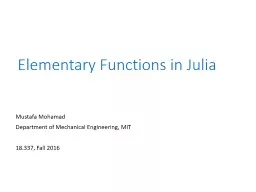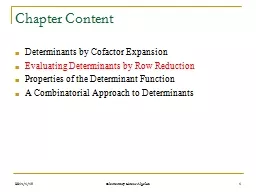PPT-Elementary Functions in Julia
Author : aaron | Published Date : 2017-06-21
Mustafa Mohamad Department of Mechanical Engineering MIT 18337 Fall 2016 Problem Develop pure Julia codes for elementary function Trigonometric functions sin cos
Presentation Embed Code
Download Presentation
Download Presentation The PPT/PDF document "Elementary Functions in Julia" is the property of its rightful owner. Permission is granted to download and print the materials on this website for personal, non-commercial use only, and to display it on your personal computer provided you do not modify the materials and that you retain all copyright notices contained in the materials. By downloading content from our website, you accept the terms of this agreement.
Elementary Functions in Julia: Transcript
Download Rules Of Document
"Elementary Functions in Julia"The content belongs to its owner. You may download and print it for personal use, without modification, and keep all copyright notices. By downloading, you agree to these terms.
Related Documents














